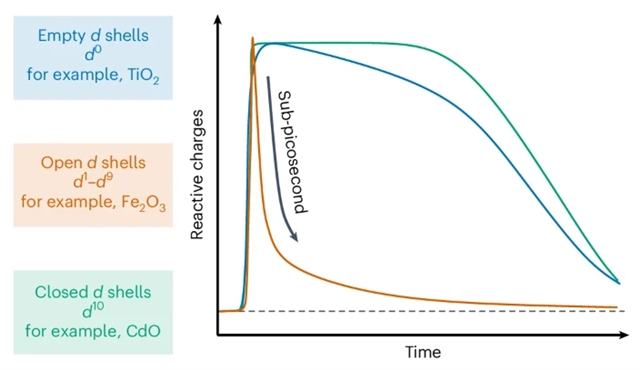
英国伦敦帝国理工学院James R. Durrant团队揭示了过渡金属氧化物光催化剂中的金属中心态控制载流子寿命。2025年7月2日出版的《自然-化学》杂志发表了这项成果。
高效的太阳光到能量转换需要能够在光照下产生长寿命电荷载流子的材料。然而,具有固有长寿命的半导体的目标设计仍然是一个关键挑战。研究组使用一系列过渡金属氧化物,建立了过渡金属基半导体中载流子寿命和电子结构之间的联系。他们通过以金属为中心的配体场态确定了一种亚皮秒弛豫机制,该机制损害了开放d壳过渡金属氧化物(例如Fe2O3、Co3O4、Cr2O3和NiO)的量子产率,这更像是分子络合物而不是晶体半导体。
研究组发现,具有自旋禁止配体场跃迁的材料可以部分缓解这种弛豫途径,这解释了为什么Fe2O3比其他可见光吸收过渡金属氧化物具有更高的光电化学活性。然而,实现长寿命电荷的高产率需要具有d0或d10电子构型的过渡金属氧化物(例如TiO2和BiVO4),其中没有配体场态。这些趋势转化为氧化物以外的含过渡金属半导体,从而能够在光伏、光催化和通信设备中设计出具有更好可控复合通道的光吸收剂。
附:英文原文
Title: Metal-centred states control carrier lifetimes in transition metal oxide photocatalysts
Author: Sachs, Michael, Harnett-Caulfield, Liam, Pastor, Ernest, Davies, Bernadette, Sowood, Daniel J. C., Moss, Benjamin, Kafizas, Andreas, Nelson, Jenny, Walsh, Aron, Durrant, James R.
Issue&Volume: 2025-07-02
Abstract: Efficient sunlight-to-energy conversion requires materials that can generate long-lived charge carriers upon illumination. However, the targeted design of semiconductors possessing intrinsically long lifetimes remains a key challenge. Here using a series of transition metal oxides, we establish a link between carrier lifetime and electronic configuration in transition metal-based semiconductors. We identify a subpicosecond relaxation mechanism via metal-centred ligand field states that compromise quantum yields in open d-shell transition metal oxides (for example, Fe2O3, Co3O4, Cr2O3 and NiO), which is more reminiscent of molecular complexes than crystalline semiconductors. We found that materials with spin-forbidden ligand field transitions could partially mitigate this relaxation pathway, explaining why Fe2O3 achieves higher photoelectrochemical activity than other visible light-absorbing transition metal oxides. However, achieving high yields of long-lived charges requires transition metal oxides with d0 or d10 electronic configurations (for example, TiO2 and BiVO4), where ligand field states are absent. These trends translate to transition metal-containing semiconductors beyond oxides, enabling the design of photoabsorbers with better-controlled recombination channels in photovoltaics, photocatalysis and communication devices.
DOI: 10.1038/s41557-025-01868-y
Source: https://www.nature.com/articles/s41557-025-01868-y
Nature Chemistry:《自然—化学》,创刊于2009年。隶属于施普林格·自然出版集团,最新IF:24.274
官方网址:https://www.nature.com/nchem/
投稿链接:https://mts-nchem.nature.com/cgi-bin/main.plex
